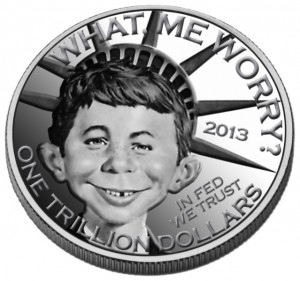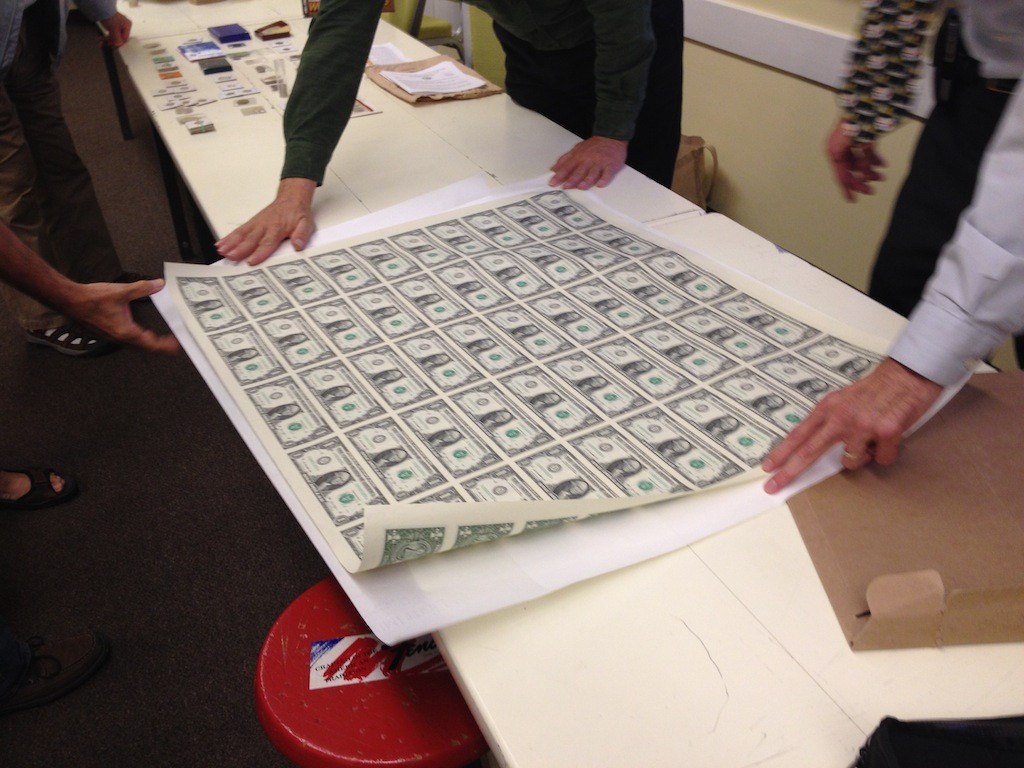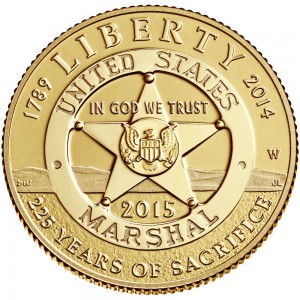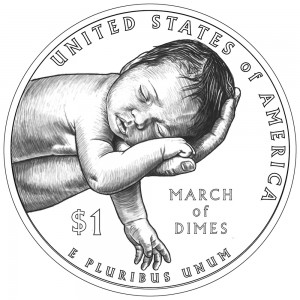When will Congress ever learn
It’s back!

(Image courtesy of Heritage Auctions)
The idea was first conjured up in 2013 by conservative economists and pundits with some minor vocal support from some members of congress. It was brought up again in 2020 by a liberal freshman member who missed the earlier lessons about why it is a stupid idea.
Now Sen. Mike Lee (R-UT) has doubled down on the moronic by introducing S. 185, Cancel the Coin Act, to “remove the Treasury Secretary’s ability to mint coins of any value.”
Mike Lee was first elected to the Senate in 2011. He was in congress when the discussion of the $1 trillion coin began. Nearly every competent member of congress on both sides of the aisle dismissed the idea. They understood that issuing a $1 trillion coin will not work.
Lee did not learn the lesson.
Lee introduced the Cancel the Coin Act as a partisan measure because he is suddenly worried about a federal deficit. Even though the deficit was projected to be $1.083 trillion before the pandemic on a budget he voted for, Lee becomes concerned because a different party is in the White House.
The last time the government tried to curb deficit spending and manipulate coinage, Treasury Secretary Andrew Mellon was on his way to being impeached. President Herbert Hoover appointed Mellon as Ambassador to the Court of St. James to get him out of town.
With the worldwide economy crashing, gold was becoming the primary means of international trade. Gold exports were happening faster than could be managed. To stop the hemorrhaging of money, congress passed the Emergency Banking Act on March 9, 1933, with bipartisan support. The act allowed the government to close the banks to allow the system to be recapitalized. It would be the last bank holiday of the Great Depression.
Om May 1, 1933, President Franklin D. Roosevelt issued Executive Order 6102 to recall gold held by the public except for some coins and jewelry. The gold would go to replenishing the country’s gold reserves. The Gold Reserve Act of 1934 codified the Executive Order.
From this point, we can pick up the story of the 1933 Saint Gaudens Double Eagles.
President Gerald Ford reversed Roosevelt’s Executive Order the same day that the law that reverse the Gold Reserve Act was signed: December 31, 1974.
While the story of the 1933 Double Eagles makes for an intriguing drama, the lesson of unintended consequences should be a concern over making political statements the way Sen. Lee is doing.
Beware of fake gold
Traveling Suspects ArrestedTwo suspects have been arrested for selling fake Suisse Pamp carded gold bars (2.5gm, 5gm,10gm and 1 ounce) at a coin shop in Greenwood, Indiana. Search of the suspects vehicle revealed multiple identification cards, business and pamphlets from different coin shops and an additional 250 fake gold bars and coins. Based upon receipts located in the vehicle the suspects had been selling the fake gold to shops in Illinois, Kentucky, Tennessee and Indiana since September, 2014.
The suspects were driving a silver Ford Focus with Missouri license plates. The suspects are being held for Theft by Deception.
Aaron Taylor
Western Union, IL
Second suspect was identified as Nelson Hernandez (No photo available) alias Benjamin Wade.
Anyone having been in contact with either of these subjects should contact:
Doug Davis, 817-723-7231, Doug@numismaticcrimes.org
If you have information, please contact Doug Davis. Let’s keep the hobby for both collectors and investors safe!
- Gold bar image courtesy of Produits Artistiques Métaux Précieux
- Mugshot courtesy of the Numismatic Crime Information Center
U.S. Mint gets a new Deputy Director
In making the announcement, Rios thanked Peterson for his service as Deputy Director. She noted that Peterson will continue to be a part of the team moving forward through the many important issues and initiatives the Mint will tackle this year.
Dick Peterson, the current Deputy Director, will return to the position of Deputy Director for Manufacturing and Quality, the job he was in prior to becoming Deputy Director.
Jeppson and Peterson are members of the Senior Executive Service (SES), the program that helps the U.S. government maintain a vibrant executive management system. As part of the SES program, government executives must take a new management position every three years. This way they maintain strong management skills and managers do not become entrenched and complacent in their jobs. Although SES guidelines encourage members to change agencies or major departments within the agencies, SES members can elect to stay in the same job with permission from the appointed executive who supervises their work.
Since the U.S. Mint does not have an appointed Director, Jeppson will be responsible for the day-to-day operation of the bureau—essentially, the U.S. Mint’s chief operating officer. Treasurer Rios remains the government equivalent of the Chief Executive Officer.
The U.S. Mint has not had a director since Edmund Moy resigned in January 2011. Given the current political climate, it is unlikely that the president will nominate a new director or, if he tries to nominate another candidate, the senate would confirm his nomination.
New Year, New Congress, and a new Director for the BEP
As congress convenes for its 114th session there are questions as to what the new Republican majority would do with their power. For numismatists waiting for congress to authorize the U.S. Mint to do anything, there may not be many changes from the last congress. Since financial bills are constitutionally required to start in the House of Representatives and since the House only increased its Republican majority, it is unlikely attitudes would significantly change. After all, in two years, the 113th congress passed only one commemorative coin bill.
Other than what happens in congress, there will be one change in numismatic production. Just before the New Year it was reported that Larry R. Felix, the Director of the Bureau of Engraving and Printing, will retire from government service effective January 31, 2015.Felix, who was born in Port of Spain, the capital of Trinidad and Tobago, was raised in New York City where he attended New York City College of Technology (City Tech) and City College of New York. He has been working for the BEP since 1993 and became the bureau’s director in 2006.
Felix was 24th director of the BEP and was the first African-American to be the Director.
Under Felix, the BEP introduced the next generation of currency designs in conjunction with the Federal Reserve and the U.S. Secret Service to make it more difficult to counterfeit U.S. currency including the new $100 Federal Reserve Note that has been recognized as the most difficult note to counterfeit. As part of the upgrade in production capabilities, Felix lead the BEP into a transition that made the bureau more technologically advanced and made their production more efficient.
Recent accomplishments include working with groups representing the visually impaired to make currency more accessible as part of a program called Meaningful Access. As part of that effort, the Meaningful Access program produced Eyenote for iOS and IDEAL Currency Identifier for Android to allow smartphone users to identify currency with their phone’s built in camera. They also are making iBill available for free to qualified visually impaired people. IBill is a pocket device that can be used to read U.S. currency and audibly identify its denomination that does not require a smartphone.
More recently, the BEP began to print one-dollar Federal Reserve Notes in sheets of 50 notes. During the production cycle, one-third of the notes being produced are $1 notes where more than 80-percent of the notes produced are used to replace worn currency. To meet the demand and lower the production cycle, this 38-percent per sheet increase in production will reduced the number of printing cycles required better meeting the demands of the BEP’s primary customer, the Federal Reserve.

BEP Deputy Director Len Olijar speaks to the Montgomery County Coin Club during their September 2014 meeting.
Unlike the U.S. Mint, the Director of the BEP is a career employee of the United States Government. BEP directors are members of the Senior Executive Service (SES), a program established as part of the Civil Service Reform Act of 1978 to “ensure that the executive management of the Government of the United States is responsive to the needs, policies, and goals of the Nation and otherwise is of the highest quality.”
Although most SES members are career employees, the government can hire qualified executives from outside of the government. These special appointments to the SES are renewable terms from three-to-five years where the appointee can only serve two appointments in the same position.
Since SES members are employees of the United States government, they are not subject to the Senatorial confirmation process political appointees must undergo. However, it is the job of the Secretary of the Treasury Jack Lew to appoint a new permanent director. It is likely Lew will make the appointment based on the recommendation of Treasurer Rosie Rios. Both Lew and Rios are political appointees whom have been confirmed by the Senate.
As an aside, the U.S. Mint has not had a director since the resignation of Edmund Moy in January 2011. Since the Director of the U.S. Mint is a politically appointed position, the U.S. Mint is legally managed by Treasurer Rosie Rios who has assigned Deputy Directory Richard A. Peterson to manage the day-to-day operations. Peterson, who is probably doing a better job than an appointee, is a career government employee and a member of the SES.
2015
And now, the end is near
And so I face the final curtain.
My friend, I’ll say it clear
I’ll state my case, of which I’m certain. . .
 As we wind down the end of a very interesting 2014, we also come to the end of the 113th Congress. This congress has been as inactive as any. Sure, there was a lot of press with faces from both sides spewing scary rhetoric about topics these people seem to know little about, but even when it comes to coining money, they have done less than any congress in recent memory.
As we wind down the end of a very interesting 2014, we also come to the end of the 113th Congress. This congress has been as inactive as any. Sure, there was a lot of press with faces from both sides spewing scary rhetoric about topics these people seem to know little about, but even when it comes to coining money, they have done less than any congress in recent memory.
Other than the passing the budget bill nicknamed “CRomnibus,” the 113th Congress passed only three bills that made it to the President’s desk. President Obama signed all three bills.
Bills Signed Into Law
- Public Law 113-10 (formerly H.R. 1071: To specify the size of the precious-metal blanks that will be used in the production of the National Baseball Hall of Fame commemorative coins. This was a technical change in the law that changed how the size of the planchet was determined that were not able to be considered when the law was introduced. This bill was signed into law by the President on May 17, 2013.
- Public Law 113-212 formerly H.R. 2366): The World War I American Veterans Centennial Commemorative Coin Act requires the Secretary of the Treasury to mint coins in commemoration of the centennial of World War I. In 2018, the U.S. Mint will strike not more than 350,000 silver dollar coins “emblematic of the centennial of America’s involvement in World War I.” The $10 per coin surcharge will be paid to the U.S. Foundation for the Commemoration of the World Wars to assist the World War I Centennial Commission in commemorating the centenary of World War I. This bill was signed into law by the President on December 16, 2014.
- Public Law 113-288 (formerly H.R. 2754: the Collectible Coin Protection Act. As I previously explained, this law enhances the Hobby Protection Act by allowing law enforcement and other legal actions against distributors and handlers of counterfeit coins and grading service holders. President Obama signed this bill into law on December 19, 2014.
Bills Passed by the House of Representatives
The following bill was passed by the House of Representatives but died in committee in the Senate.
- H.R. 2866: Boys Town Centennial Commemorative Coin Act
Bills Introduced in the House of Representatives
These are the bills that were introduced in the House of Representatives but died in the various committees. While it may not be apparent from the titles, all of these bills have some impact on the coinage that would be produced by the U.S. Mint:
- H.R. 77: Free Competition in Currency Act of 2013
- H.R. 220: Stop the Coin Act
- H.R. 627: National Park Service 100th Anniversary Commemorative Coin Act
- H.R. 1218: Commemorative Coins Reform Act of 2013
- H.R. 1653: Pro Football Hall of Fame Commemorative Coin Act
- H.R. 1719: Cents and Sensibility Act
- H.R. 1905: Mother’s Day Centennial Commemorative Coin Act
- H.R. 2366: World War I American Veterans Centennial Commemorative Coin Act
- H.R. 2633: Thirteenth Amendment Commemorative Coin Act
- H.R. 2760: Panama Canal and Pan-Pacific Exhibition Centennial Celebration Act
- H.R. 2932: United States Coast Guard Commemorative Coin Act
- H.R. 3146: Savings, Accountability, Value, and Efficiency (SAVE) II Act
- H.R. 3305: Currency Optimization, Innovation, and National Savings Act
- H.R. 3680: Breast Cancer Awareness Commemorative Coin Act
- H.R. 3729: Korean Immigration Commemorative Coin Act
Bills Introduced in the Senate
Coinage bills are considered revenue bills because they earn the federal government money and are used to raise funds that are paid by the government to public and private organizations. Even though the United States Constitution requires revenue bills to begin in the House of Representatives, it is not beneath the Senate to introduce their own legislation. Sometimes, senators introduce concurrent bills—bills that are similar to the one introduced in the House as a mechanism to get one of them passed. These are the bills that were introduced in the Senate that died in committee:
- S. 94: To terminate the $1 presidential coin program
- S.203: Pro Football Hall of Fame Commemorative Coin Act
- S. 768: Sound Money Promotion Act
- S. 1011: Boys Town Centennial Commemorative Coin Act
- S. 1105: Currency Optimization, Innovation, and National Savings Act
- S. 1158: National Park Service 100th Anniversary Commemorative Coin Act
- S. 1842: Pro Football Hall of Fame Commemorative Coin Act
- S. 2303: United States Coast Guard Commemorative Coin Act
- S. 2310: Mother’s Day Commemorative Coin Act
With that, we close the books on the 113th Congress.








